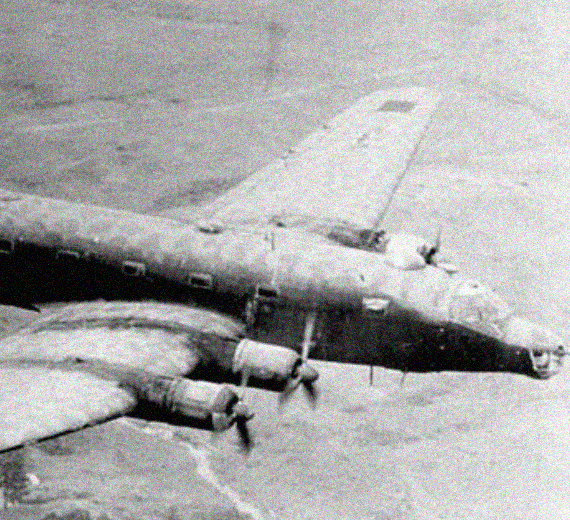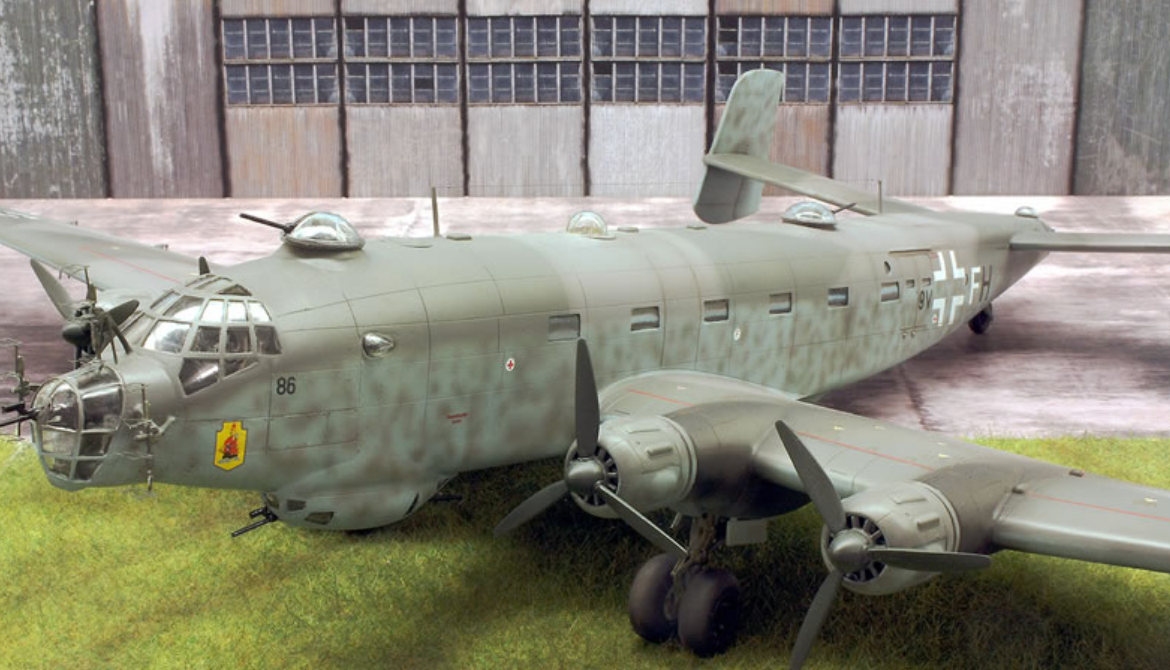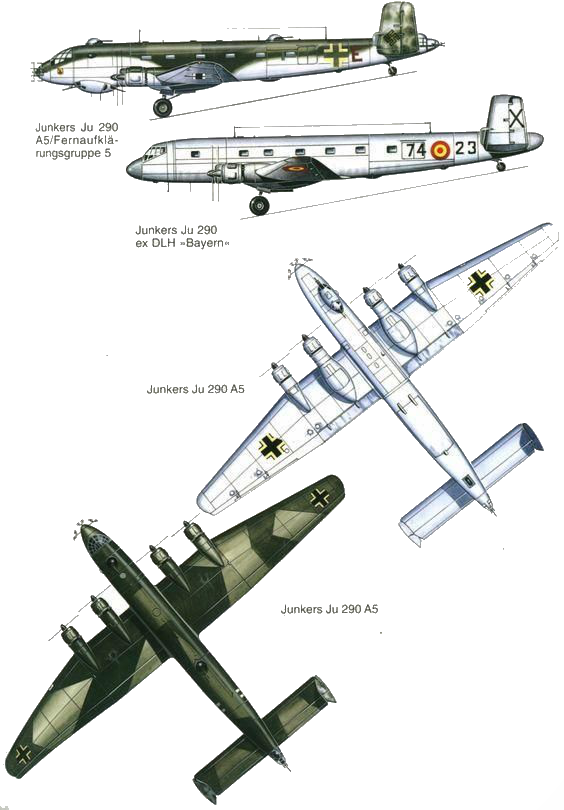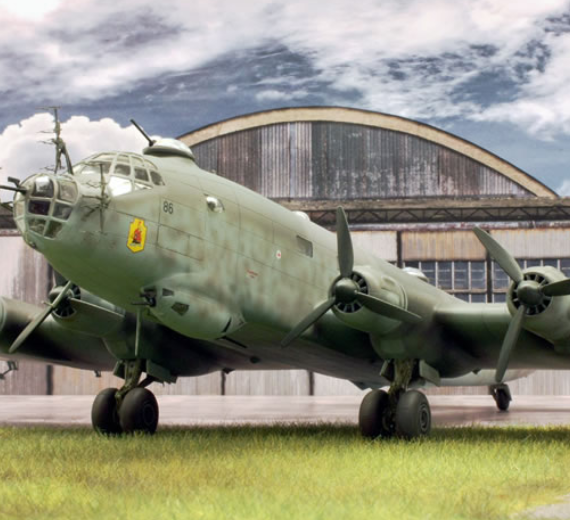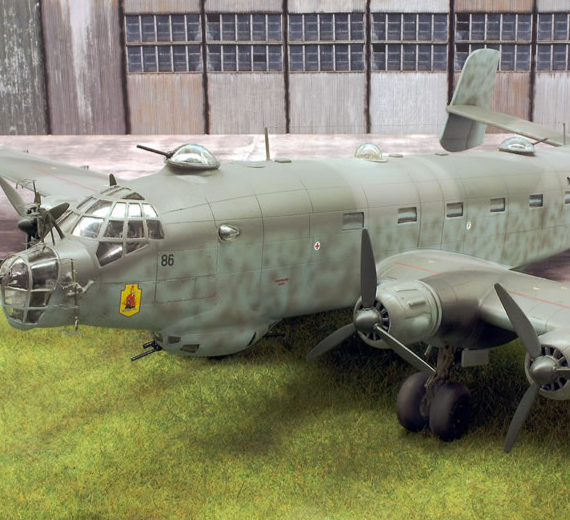Junkers
Junkers Ju 290
Role Maritime patrol, Transport, Heavy bomber
Manufacturer Junkers
Designer Konrad Eicholtz
First flight 16 July 1942 (Ju 290 V1)
Introduction August 1942
Primary users Luftwaffe
Spain (Post war)
Produced 1942–1946
Number built 65
Developed from Junkers Ju 90
Variants Junkers Ju 390
.
History Junkers Flugzeug- und Motorenwerke AG JFM
Junkers Ju 290 Transport

The Junkers Ju 290 was a large German, four-engine long-range transport, heavy bomber and maritime patrol aircraft used by the Luftwaffe late in World War II that had been developed from an earlier airliner.
The Junkers 290 was developed directly from the Ju 90 airliner, versions of which had been evaluated for military purposes, and was intended to replace the relatively slow Focke-Wulf Fw 200 Condor which by 1942 was proving increasingly vulnerable when confronted by Royal Air Force aircraft; the Fw 200's airframe lacked sufficient strength for the role in any case. The Ju 290 was also intended to meet the need for large transport aircraft. A bomber version, the A-8, was planned, but never built. Design was headed by Konrad Eicholtz..
Design


The development programme resulted in the Ju 290 V1 prototype BD+TX, which first flew on 16 July 1942. It featured a lengthened fuselage, more powerful engines, and a Trapoklappe hydraulic rear loading ramp. Both the V1 and the first eight A-1 production aircraft were unarmed transports. The need for heavy transports saw the A-1s pressed into service as soon as they were completed. Several were lost in early 1943, including one taking part in the Stalingrad Airlift, and two flying supplies to German forces in Tunisia, and arming them became a priority
Operational history


A special long-range reconnaissance group, FAGr 5 (Fernaufklärungsgruppe 5), had been formed on 1 July 1943 and during the late summer of 1943 three of the new Ju 290 A-2s were delivered to its 1 Staffel, which became operational at Mont-de-Marsan near Bordeaux on 15 October of that year. They flew their first operational missions in November 1943, shadowing Allied convoys in cooperation with U-boats, often remaining airborne for up to 18 hours.
0
KmCeiling
0
KmCombat RANGE
0
Km/hAircraft Speed
0
Max Crew
Photo Gallery
Junkers Flugzeug- und Motorenwerke AG JFM
Junkers Ju 290 Transport


Junkers Flugzeug- und Motorenwerke AG JFM
Junkers Ju 290 Transport
General Info
-
-
- Crew: 9
- Length: 28.64 m (94 ft 0 in)
- Wingspan: 42 m (137 ft 10 in)
- Height: 6.83 m (22 ft 5 in)
- Wing area: 205.3 m2 (2,210 sq ft)
-
Powerplant
-
- Empty weight: 24,000 kg (52,911 lb)
- Gross weight: 40,970 kg (90,323 lb)
- Max takeoff weight: 44,969 kg (99,140 lb)
- Powerplant: 4 × BMW 801G 14-cylinder air-cooled radial piston engines, 1,300 kW (1,700 hp) each for take-off
-
-
- 1,080 kW (1,450 hp) at 2,000 m (6,560 ft)
- 980 kW (1,310 hp) at 5,800 m (19,030 ft)
-
-
Performance
- Maximum speed: 439 km/h (273 mph, 237 kn) at 5,800 m (19,030 ft)
- Cruise speed: 360.5 km/h (224.0 mph, 194.7 kn) at 5,800 m (19,030 ft)
- Range: 6,148 km (3,820 mi, 3,320 nmi) with 21,003 L
- Service ceiling: 6,000 m (19,685 ft)
- Time to altitude: 1,860 m (6,090 ft) in 9 minutes 48 seconds at(40,970 kg)
Armament
-
- Guns: ** 2 × 20 mm (0.787 in) MG 151/20 cannons or MG 151/15 cannon in dorsal turrets
- 1 × 20 mm (0.787 in) MG 151/20 in tail
- 2 × 13 mm (0.512 in) MG 131 machine guns in waist
- 1 × 20 mm (0.787 in) MG 151/20 or 1 x 30 mm (1.181 in) MK 103 cannon in front gondola
- 2 × 13 mm (0.512 in) MG 131 machine guns in rear gondola
- Bombs: Up to 3,000 kg (6,600 lb) of disposable stores or three Fritz X, F5W torpedoes or Henschel Hs 293 radio-guided munitions
- Guns: ** 2 × 20 mm (0.787 in) MG 151/20 cannons or MG 151/15 cannon in dorsal turrets
.
Links to Youtube & Others
During its service with Luft Hansa, the Ju 52 had proved to be an extremely reliable passenger airplane. This positive experience contributed to its adoption by the Luftwaffe as a standard aircraft model.
Junkers Ju 290 Transport Heavy bomber
Lightly armed, and with a top speed of only 265 km/h (165 mph) — half that of a contemporary Hurricane — the Ju 52 was very vulnerable
Youtube Link
The Colombian Air Force used three Ju 52/3mde bombers equipped as floatplanes during the Colombia-Peru War in 1932–1933.

